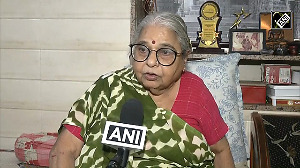On January 31, 2012, Dassault Aviation's Rafale won the bid to supply the Indian Air Force with 126 medium multi-role combat aircraft. The multi-billion dollar 'deal of the century' has since languished over price negotiations.
Rahul Bedi explains how 'miscellaneous' factors have posed a major hurdle in negotiating the Rafale deal. 
There is a delicious, albeit hugely expensive, irony involving the ongoing negotiations to procure 126 Dassault Rafale fighters that, in some aspects, parallels the purchase of six French Scorpene submarines nearly a decade ago.
Both deals straddled general elections a decade apart -- 2004 and 2014 -- featuring governments that initiated procurement procedures of the respective military platforms, but were voted out of office before inking them.
The BJP-led National Democratic Alliance began negotiating the Project 75 Scorpene contract with France in 2001, but the succeeding Congress Party-headed United Progressive Alliance eventually concluded the purchase in October 2005, some 18 months after forming the government.
The UPA, for its part, began discussions with Dassault in early 2012 for 126 Rafale’s in support of the Indian Air Force’s requirement for Medium Multi Role Combat Aircraft, after the French fighter was shortlisted from amongst six competing platforms from Europe, Russia and the US.
National polls intervened before the complex and costly deal could be concluded; and, in a sardonic reversal of roles, the Rafale deal now awaits NDA administration's imprimatur.
The subtle irony underlying these two major acquisitions entails more than just the same cast of players -- French armament companies, the Congress Party and the BJP.
It involves hugely escalating costs, questionable bids and complex and extended price negotiations which both the ministry of defence and respective service headquarters seem inept in handling.
The comparison between the Scorpene purchase and the prospective Rafale acquisition need elaborating.
In October 2005, the UPA signed the Rs 18,798 crore deal for six Scorpene submarines to be built by Mazagaon Dockyard Limited under a transfer of technology from Armaris comprising Direction des Constructions Navales and Thales of France and Spain’s Navantia.
After a series of mergers and acquisitions, this consortium emerged as DCNS in 2007 with whom all future dealings have subsequently been conducted.
Problems arose shortly after construction of three Scorpene boats began in 2007-08.
It emerged that the original agreement had mysteriously omitted to include varied critical components essential to the Scorpene’s construction including engines, generators, sub-assemblies and raw material like specialised steel.
Accordingly, the Cabinet Committee on Security headed by then Prime Minister Manmohan Singh -- presented a fait accompli as MDL had already begun building the Scorpene’s -- was forced in March 2010 into approving an additional Rs 1,900 crore for the newly-created Mazagaon Procurement Materials.
The MPM, as a postscript to the main submarine contract agreed to five years earlier, emerged as vital entity to source the additional apparatus from DCNS to kick-start the stalled Scorpene programme.
The protracted negotiations to purchase this gear -- which raised the overall submarine contract price by some 10 per cent -- lasted almost 24 months and were primarily responsible for delaying the programme by four years to 2016.
This postponement, in turn, has added serious dimension to the Indian Navy’s operational woes afflicted by its depleting underwater assets.
But more notably, this lapse in conclusively negotiating the Scorpene deal at one go appears to be one by MoD and naval officials who were either professionally incompetent or deliberately careless or both in determining essential equipment that puzzlingly and in all probability, much to DCNS’ delight, emerged later.
At the time of the follow-on agreement with the MPM, defence industry officials had held DCNS responsible for significantly inflating the cost of these supplementary items on the grounds that a large proportion needed procuring from other European suppliers.
Hence, it can be surmised that these ‘assorted’ items were either skilfully or inadvertently omitted from the Scorpene bid or simply tagged on as ‘miscellaneous’ only to be negotiated later, once the submarines construction has started leaving the MoD and Navy no alternative but to acquire them. 
In what appears to be a rerun of the Scorpene project, around 50-60 ‘un-priced’ items are believed to have been listed as miscellaneous’ in Dassault’s offer for the Rafale which emerged as L1 or the lowest bidder in the MMRCA tender ahead of the Eurofighter.
MoD sources claim that it is these sundry articles that have emerged as the principal financial hurdle in negotiating the Rafale deal on the basis of its Life Cycle Cost based on keeping the fighter operational for four decades.
It appears that subsequent pricing by Dassault of these so-called miscellaneous but critical items -- like in the Scorpene tender -- in its deliberations with the MoD’s Cost Negotiation Committee, are responsible for significantly inflating the Rafale contract cost, jeopardising the vendors L1 status and delaying its closure.
Official sources indicate the Rafale procurement has reportedly more than doubled from Rs 42,000 crore (then around $9 billion) earmarked for the MMRCA tender, when it was floated in 2007, to around $20 billion.
Spiraling inflation and the 15-20 per cent decline in the value of the rupee against the US dollar too have contributed to the cost escalation.
Consequently, each Rafale is now reportedly priced between $110-120 million.
The cost of the plant, machinery and tooling which Dassault is required to transfer to Hindustan Aeronautics Limited to licence build 108 of the 126 Rafale’s in Bangalore has also escalated adding to the overall contract price.
But this seemingly Scorpene-like tactic of tagging on ‘miscellaneous’ items to the Rafale contract is unacceptable to the MoD.
Instead, these are deemed by the MoD to be part of Dassault’s final bid, an arrangement that is reportedly unacceptable to the French manufacturer who is seeking to negotiate their costing.
However, what does prompt embarrassing questions for the MoD and the IAF is their failure or worse, possible collusion in categorically evaluating bids, leaving vendors to spring un-anticipated and hugely expensive surprises upon them once it was too late to pull back.
Hypothetically, if the Rafale deal were to be terminated, the entire process to acquire another MMRCA would, under existing Defence Procurement Procedures, begin afresh at a time when the IAF is concerned over its depleting combat squadrons and anxieties about operating ageing assets by extending their total technical life.
Any such move would also seriously dent Prime Minister Narendra Modi’s assertions of upgrading India’s depreciated military capability.
Paradoxically, the ongoing tussle between the MoD and Dassault over the Rafale tender has also prompted a Mexican stand off between the two, in which the latter is not without advantage.
The IAF’s swiftly declining numerical superiority in combat platforms compared with the Pakistan Air Force and the correspondingly widening gap with the Peoples Liberation Army Air Force is, in a sense, a force multiplier for Dassault.
For More Defence News, CLICK HERE









